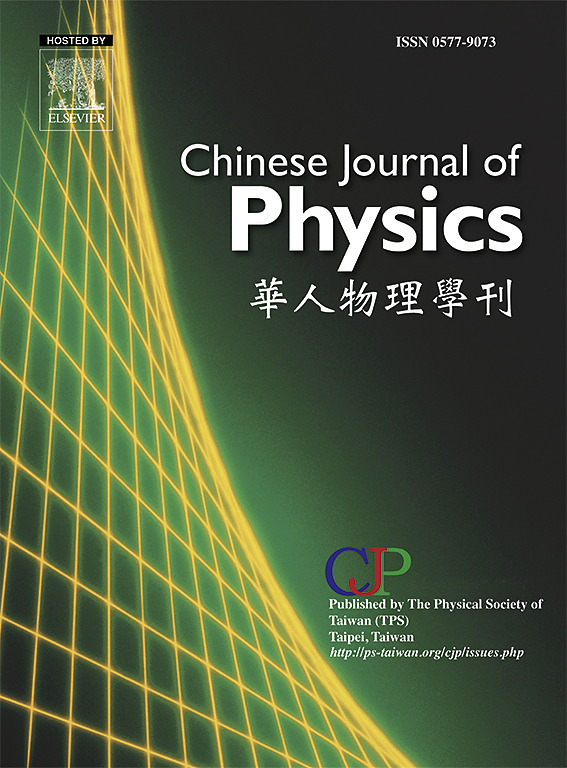电渗透MHD剪切减薄纳米流体通过具有滑移依赖zeta电位的微通道的不可逆性估计
IF 4.6
2区 物理与天体物理
Q1 PHYSICS, MULTIDISCIPLINARY
引用次数: 0
摘要
剪切变薄纳米流体在医学诊断和控制运输过程的工程装置中非常有用。这涉及到在压力驱动和电磁力下使用微通道流动。此外,非牛顿流体的组合模型提供了一个通用的框架,以准确地模拟或预测各种工业,科学和生物医学应用中的流体行为。在这项研究中,我们研究了剪切变薄纳米流体在具有渗透性壁的垂直微通道中流动时的传热和传质,以及电动力学效应、滑移依赖的ζ势和对流边界条件。为了描述剪切减薄行为,采用了Casson-Williamson非牛顿流体模型。流体运动包括压力诱导和电渗透力的融合,受热辐射和滑移相关的ζ势的影响。利用MATLAB bvp4c求解器,通过求解由控制方程得到的无量纲微分方程,突出了电渗透流(EOF)对纳米流体的影响。重要工程量的图形表示用于识别关键的影响因素。结果表明,较薄的双电层(edl)放大了Casson-Williamson参数对温度分布的影响。此外,当η=1.0时,较高的电渗参数增强了Williamson参数对浓度分布的影响。我们观察到,传热在通道核心区域的熵产中起最小作用,但在通道壁上呈指数增长。相反,在远离壁的地方,由于质量传递而产生的熵可以忽略不计。然而,Casson参数β有利于整个通道横截面的熵产生,而Williamson参数Γ在通道的两半中显示相反的效果。本研究对电磁机械器件的发展、效率和功能的提高,特别是在微尺度热管理应用方面具有重要意义。本文章由计算机程序翻译,如有差异,请以英文原文为准。

Irreversibility estimation in electroosmotic MHD shear thinning nanofluid flow through a microchannel with slip-dependent zeta potentials
Shear-thinning nanofluid is extremely useful in medical diagnostics and engineering devices for controlling transport processes. This involves using microchannel flow under pressure-driven and electromagnetic forces. Moreover, a combined model of non-Newtonian fluid provides a versatile framework to accurately simulate or predict fluid behavior in various industrial, scientific, and biomedical applications. In this study, we investigate the heat and mass transfer of a shear-thinning nanofluid as it flows through a vertical microchannel with permeable walls, with electrokinetic effects, slip-dependent zeta potential, and convective boundary conditions. To characterize the shear-thinning behavior, a combined Casson-Williamson non-Newtonian fluid model is utilized. The fluid motion comprises a fusion of pressure-induced and electroosmotic forces, influenced by thermal radiation and slip-dependent zeta potential. Using the MATLAB bvp4c solver, we highlight the effect of electroosmotic flow (EOF) for the nanofluid by solving the non-dimensional differential equations resulting from the governing equations. Graphical representations of important engineering quantities are used to identify the critical influential factors. Our results show that thinner electric double layers (EDLs) amplify the influence of the Casson-Williamson parameters on the temperature profile. Additionally, the impact of the Williamson parameter at on concentration distribution is enhanced for higher electroosmotic parameters. We observe that heat transfer plays a minimal role in entropy generation in the core region of the channel but increases exponentially near the walls. Conversely, entropy production due to mass transfer is negligible away from the walls. However, the Casson parameter favors entropy production throughout the channel cross-section, while the Williamson parameter shows the reverse effect in both halves of the channel. This study has significant implications for the advancement of electro-magneto-mechanical devices and the improvement of efficiency and functionality, particularly in micro-scale thermal management applications.
求助全文
通过发布文献求助,成功后即可免费获取论文全文。
去求助
来源期刊

Chinese Journal of Physics
物理-物理:综合
CiteScore
8.50
自引率
10.00%
发文量
361
审稿时长
44 days
期刊介绍:
The Chinese Journal of Physics publishes important advances in various branches in physics, including statistical and biophysical physics, condensed matter physics, atomic/molecular physics, optics, particle physics and nuclear physics.
The editors welcome manuscripts on:
-General Physics: Statistical and Quantum Mechanics, etc.-
Gravitation and Astrophysics-
Elementary Particles and Fields-
Nuclear Physics-
Atomic, Molecular, and Optical Physics-
Quantum Information and Quantum Computation-
Fluid Dynamics, Nonlinear Dynamics, Chaos, and Complex Networks-
Plasma and Beam Physics-
Condensed Matter: Structure, etc.-
Condensed Matter: Electronic Properties, etc.-
Polymer, Soft Matter, Biological, and Interdisciplinary Physics.
CJP publishes regular research papers, feature articles and review papers.
 求助内容:
求助内容: 应助结果提醒方式:
应助结果提醒方式:


